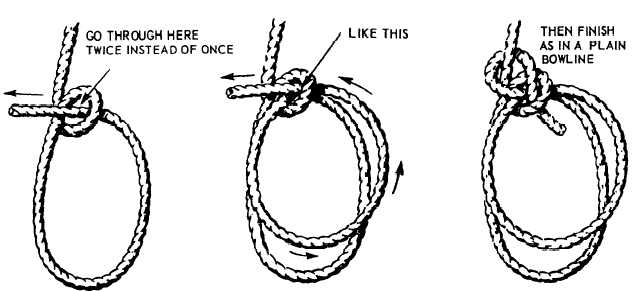| |
Figure 3-17.–Tying a French bowline.
the steps in tying a single and a double becket bend.
A double becket bend is always used to bend the
gantline (riding up and down line) onto a boatswain's
chair.
The carrick bend (fig. 3-14) is an easy knot formed
by two overhand loops crossing each other. It provides
a very secure means of fastening two hawsers together,
and has the advantage that when drawn taut, it assumes
a form that can be passed around a barrel or winch. The
ends should be seized down on their standing parts for
security.
Another method of quickly bending two lines
together is the bowline bend. It is formed of two
bowlines one crossing the loop of the other.
KNOTS TO FORM A
LOOP OR EYE
The bowline (fig. 3-15) is the standby for
putting a loop in the end of a line. It neither slips
nor jams, yet unties easily. A bowline is the best
knot to use for bending a heaving line or
messenger to the eye of a hawser because it is
quick to tie and easy to get off.
A bowline on a bight gives two loops instead of one,
neither of which slips. It is used to hoist a person,
chair-seat fashion, out of a lifeboat or hold. Figure 3-16
shows you how to tie a bowline on a bight. As you can
see, you start with your line doubled.
A French bowline has the same purpose as a
bowline on a bight. It gives you two loops that can be
adjusted to fit. Adjust one of the loops under both hips,
the other under the armpits, and draw the loops tight
with the knot at the chest. You can transport an
unconscious crew member safely in a properly secured
bowline if you take care not to allow the part under the
arms to catch on any projections. A step-by-step
example of how to make a French bowline is given in
figure 3-17.
A running bowline is just regular bowline made
around the standing part of its line to form a
running noose. Just tie a small bowline around the
line's standing part, keeping it slack enough to run
freely.
BENDING TO A HOOK,
RING, OR SPAR
You can use a hitch to secure a line to a hook, ring
or spar. We will describe various hitches in this section.
A hitch differs from a knot in that it ordinarily is tied
to a ring, around a spar or stanchion, or around another
line. It is not tied back on itself to form an eye or to bend
two lines together.
The rolling hitch is one of the most useful and
important hitches on deck.
Use it for passing a stopper on a mooring line when
shifting the line from a winch or capstan to a cleat or
bitts. It may also be used to secure a taut line back on
itself. If tied properly, it holds as long as there is a strain
on the hitch.
3-13
|

